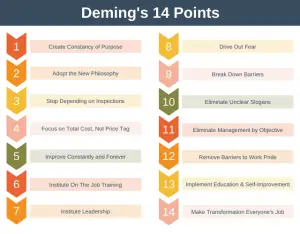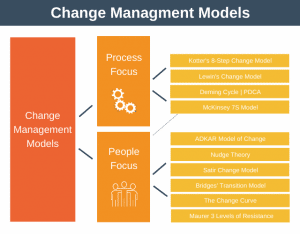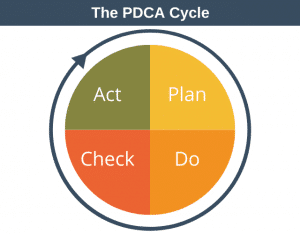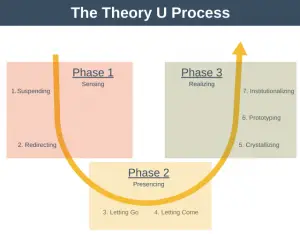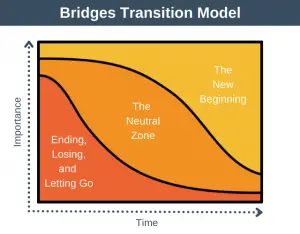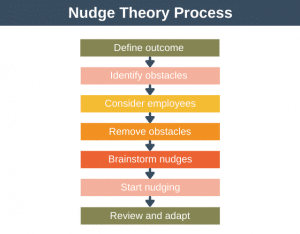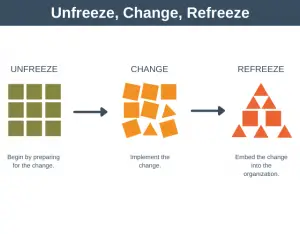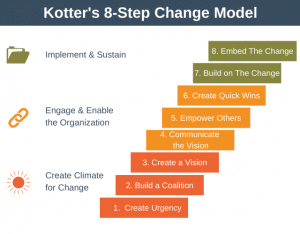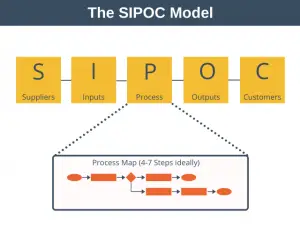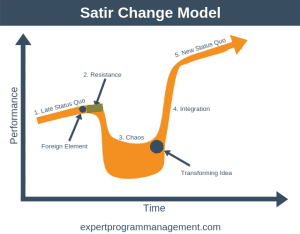The Prosci ADKAR Model is a goal-based change management model that can be used to guide both individual and organizational change.
Whether you’re an individual trying to lose weight or a 10,000 employee strong organization looking to transform itself, successful change is hard.
Understanding and using the ADKAR change management model can give you a greater chance of making your change successful.
The model came about by analyzing successful and unsuccessful change within hundreds of organizations over several years. It was developed by Jeff Hiatt in the 1990s.
The model is different from many other change management models because is it focuses on guiding change at the individual level. In contrast, most change models drive change at the organizational level.
It focuses on the individual because, even if you’re trying to transform a large organization, successful change occurs only when each individual in the team is able to change. In a nutshell, for an organization to change, the people within that organization must change.

The ADKAR framework is an acronym made up of the five steps a person needs to undertake in order to be willing and able to change. You carry out the steps in order, with each step building on the previous step.
The ADKAR Model allows leaders and change managers to focus their efforts on driving individual change. Doing this will, in turn, drive organizational change.
The ADKAR Model Steps
Let’s jump in and take a look at the model. Before we do so, note that each of the model’s steps is named for the outcome from that step. This will make more sense as we go through the steps.
1. Awareness
The outcome of this step is that everyone has an awareness and understanding of the need to change. Each individual needs to be aware of why the change is happening and why the change is necessary.
Without a full understanding of why the change is necessary employees will be unmotivated. This makes the change less likely to succeed.
A key role of management in this step is to ensure everyone understands the need for change.
2. Desire
The outcome of this step is that everyone has the desire to take part in and support the change.
To achieve this outcome it is important to work with all individuals to achieve three aims. First, that they feel dissatisfied with the current state of affairs. Second, they should understand the negative consequences of keeping things the same. Third, people need to want to participate in the change.
To achieve the final aim it’s important to explain on an individual basis what’s in it for them. This could mean enhanced job security, a sense of belonging to a team, career advancement, or even financial incentives.
3. Knowledge
The outcome of this step is the individual knowing how to change.
There are two types of knowledge according to the ADKAR Model:
- Knowing what they need to do during the transition (how to change).
- Knowing the future skills and behaviors, they need once the change is in place.
Knowledge is only useful when stages one and two are complete, and the individual already has the awareness and desire to change.
There are many ways to impart this knowledge:
- Through formal education and training.
- Coaching and mentoring.
- Workshops.
4. Ability
The outcome of this step is that the individual can demonstrate the desired new skills and behaviors.
A great aspect of the ADKAR Model is its distinction between theory and practice. Once the theory of how to change is in place, that is, the knowledge, the individual needs to be supported to acquire and practice that behavior (the ability).
Ways for management to support new working methods include providing any training needed and providing access to any resources employees need to build their ability.
5. Reinforcement
The final step’s outcome is that the new change and any new behaviors are reinforced within each individual. To sustain the change, we don’t want individuals reverting to the old ways of doing things.
Many methods exist to ensure that individuals don’t revert to previous ways of working or thinking, including:
- Taking corrective actions quickly.
- Positive reinforcement.
- Feedback.
- Rewards and recognition.
- Celebrations.
This step is often the most difficult to perform. The reason for this is because as soon as one change “goes live,” the organization immediately moves on to thinking about the next change without giving reinforcement the time it needs.
Implementing the ADKAR Model in Practice
The following diagram can be really useful in summarising who should do what and how when using the ADKAR model.
| Awareness of the need to change | Business leaders, sponsors, line manager | Communication, coaching, storytelling, 1-to-1 meetings. |
| Desire to support and take part in the change | Business leaders, sponsors, line manager, the project team | Coaching, resistance management, incentives. |
| Knowledge of how to change | Project team, HR | Training, coaching. |
| Ability to implement the change | Project team, HR, line manager | Feedback, coaching, and tools and facilities needed. |
| Reinforcement to sustain the change | Business leaders, line manager | Corrective action, feedback, positive reinforcement, rewards, celebrations. |
Individuals that make up the organization don’t just change in isolation. As they change so does the organization. In the following diagram, the traditional stages of organizational change are mapped to the ADKAR Model.
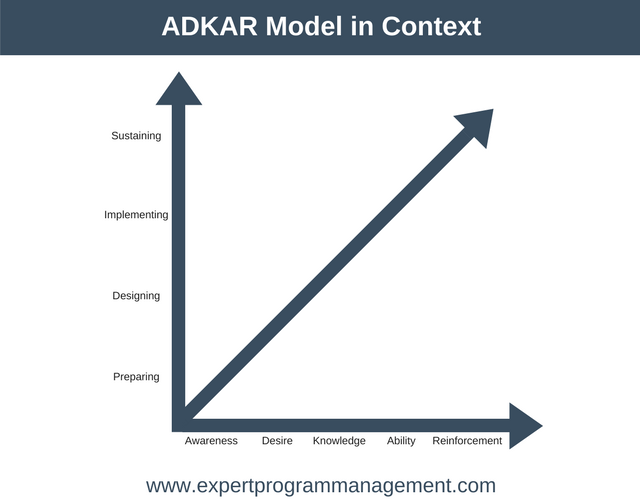
ADKAR Model Advantages
There are a number of advantages to using the model, including:
- It focuses on outcomes rather than tasks. Most change management models focus on what needs to be done but ADKAR focuses on achieving outcomes.
- The model can be used to measure how well the change is progressing. For each step of the model, progress can be measured at the individual level. Any gaps identified can then be rectified.
- The model recognizes that it is ultimately people that facilitate change and not simply processes.
- It provides a clear checklist of things that need to be done to manage change.
ADKAR Model Disadvantages
There are several disadvantages associated with the model.
- It ignores the complexity of change. Meaning it ignores the need to have a vision and create a long-term step-by-step plan to reach that vision, possibly over many years with course corrections along the way.
- It is better suited to smaller change initiatives. Only focussing on the people dimension isn’t enough to make large-scale change happen.
Summary
The ADKAR Model is a change management framework. The steps of the model are Awareness, Desire, Knowledge, Ability, and Reinforcement.
Unlike most other change management models, ADKAR focuses on the human element of change. It recognizes that individuals must change in order to make an organizational change successful.
